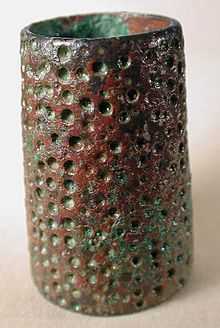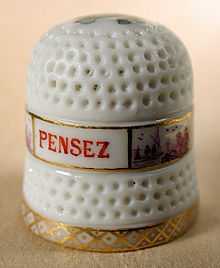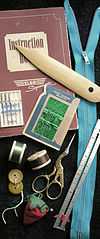Thimble


A thimble is a small hard pitted cup worn for protection on the finger that pushes the needle in sewing. Usually, thimbles with a closed top are used by dressmakers but special thimbles with an opening at the end are used by tailors as this allows them to manipulate the cloth more easily. Finger guards differ from tailors’ thimbles in that they often have a top but are open on one side. Some finger guards are little more that a finger shield attached to a ring to maintain the guard in place. The Old English word þȳmel, the ancestor of thimble, is derived from Old English þūma, the ancestor of our word thumb.[1]




Thimbles are usually made from metal, leather, rubber, and wood, and even glass or china. Early thimbles were sometimes made from whale bone, horn, or ivory. Natural sources were also utilized such as Connemara marble, bog oak, or mother of pearl. Rarer works from thimble makers utilized diamonds, sapphires, or rubies.
Advanced thimblemakers enhanced thimbles with semi-precious stones to adorn the apex or along the outer rim. Cabochon adornments are sometimes made of cinnabar, agate, moonstone, or amber. Thimble artists would also utilize enameling, or the Guilloché techniques advanced by Peter Carl Fabergé.[5]
Originally, thimbles were used simply solely for pushing a needle through fabric or leather as it was being sewn. Since then, however, they have gained many other uses. From the 16th century onwards[6] silver thimbles were regarded as an ideal gift for ladies.
Before the 18th century the small dimples on the outside of a thimble were made by hand punching, but in the middle of that century, a machine was invented to do the job. If one finds a thimble with an irregular pattern of dimples, it was likely made before the 1850s. Another consequence of the mechanization of thimble production is that the shape and the thickness of the metal changed. Early thimbles tend to be quite thick and to have a pronounced dome on the top. The metal on later ones is thinner and the top is flatter.


Early American thimbles made of whale bone or tooth featuring miniature scrimshaw designs are considered valuable collectibles. Such rare thimbles are prominently featured in a number of New England Whaling Museums.[9]
During the First World War, silver thimbles were collected from "those who had nothing to give" by the British government and melted down to buy hospital equipment.[10] In the 1930s and 40s glass-topped thimbles were used for advertising. Leaving a sandalwood thimble in a fabric store was a common practice for keeping moths away.[11] Thimbles have also been used as love-tokens and to commemorate important events. People who collect thimbles are known as digitabulists. One superstition about thimbles says that if you have three thimbles given to you, you will never be married.[12]
Known thimble makers

Most of these thimble makers are no longer in existence.
- Avon Fashion Thimbles
- Wicks (Inventor USA)
- A Feaù and René Lorillon (French)
- Charles Horner (UK) (1837–1896)
- Charles Iles (UK)
- Charles May
- Anthony Stavrianoudakis (GR)
- Gabler Bros (German)
- Henry Fidkin (UK)
- Henry Griffith (UK)
- James Fenton (UK)
- James Swann (UK)
- Jean Levy (France)
- Johan Caspar Rumpe (Germany)
- Ketcham & McDougall (USA) (Out of Business 1988)
- Meissen (German)
- Roger Lenain (French)
- Samuel |Foskett (UK)
- Simons Bros Co (USA)[13]
- Stern Bros & Co (USA)
- Waite-Thresher (USA)
- Webster (USA)
- William Prym (Germany)
Thimblette

Thimblettes (also known as rubber finger, rubber thimbles and finger cones) are soft thimbles, made predominately of rubber, used primarily for leafing through or counting documents, bank notes, tickets or forms. They also protect against paper cuts as a secondary function. Unlike thimbles, the softer thimblettes become worn over time. They are considered disposable and sold in boxes. The surface is dimpled with the dimples inverted to provide better grip. Thimblettes are sized from 00 through to 3.
Cultural references
In the Parker Brothers board game Monopoly, first created in 1904, the thimble is one of the eight traditional metal game pieces used to mark a player's position on the game board.
Thimbles are given as gifts in Peter Pan, who thinks thimbles are kisses.
In the 1992 movie Batman Returns, Catwoman, played by Michelle Pfeiffer, used thimbles to create the base of her claws.
The popular TV show and comic strip Popeye was originally called Thimble Theatre Starring Popeye.
The character Elizabeth in the video game BioShock Infinite uses a thimble to cover her severed little finger.
Video montages and series of clips are often called "thimble collections."
Auction records
On December 3, 1979, a London dealer bid the sum of $18,000 USD for a dentil shaped Meissen porcelain thimble, circa 1740, at Christie's auction in Geneva, Switzerland. The thimble, just over a half inch high, was painted in a rare lemon-yellow color about the band. It also had tiny harbor scene hand painted within gold-trimmed cartouches. The rim was scalloped with fired gold on its bottom edge. The thimble now belongs to a Meissen collector in Canada who wanted it for its lemon-yellow color.[14]
During November 1994, Sirthey's saleroom yielded a one of a kind Meissen thimble bearing an armorial coat of arms at the price of GBP 26,000.
On 13 June 1995, Sotheby's sold a Meissen thimble adorned with two pugs for GBP 10,350.
Additional pictures
-

17c English silver
-

17c Jacobean brass
-

17c Jacobean silver
-

18c French gold
-

18c Silver filigree with scent bottle
-

19c Dutch fingerguard
-

19c English Tunbridge (wood)
-

19c French mother of pearl- Palais Royal
-

20c English souvenir - Abbotsford House
-
.jpg)
20c Norwegian enamel (basse-taille)- David Anderson
-

20c English souvenir - Abbotsford House
-

Pre-revolution Russian silver gilt filigree
-

Pre-revolution Russian gold
-

20c Royal Worcester - William Powell painter
-

20c Swedish gold
-

20c French silver - F Vernon 'Sewing girls'
-

20c Norwegian enamel (guilloché)
References
- ↑ thimble. (2004). In Word Histories and Mysteries. Retrieved from http://www.credoreference.com/entry/hmwhm/thimble,retrieved March 21, 2012.
- ↑ Little Thimble, Big Journey. http://www.saudiaramcoworld.com/issue/201205/little.thimble.big.journey.htm
- ↑ United Kingdom Detector Finds Database, Thimbles page, retrieved April 24, 2010.
- ↑ UK Detector Finds Database, http://www.ukdfd.co.uk/pages/thimble.html, retrieved April 24, 2010.
- ↑
- ↑ Holmes EF. A history of thimbles. London: Cornwall Books, 1985.pp.178
- ↑ Dreesmann C. A thimble full.… Utrecht/Netherlands: Cambium, 1983. pp.75.
- ↑ http://www.funtrivia.com/en/subtopics/Thimbles-Not-as-Simple-as-they-Seem-319258.html
- ↑ The Hunt Collection, Washington Historical Society, Washington, Connecticut.
- ↑ http://findingshakespeare.co.uk/a-history-of-the-humble-thimble
- ↑ Holmes EF. A history of thimbles. London: Cornwall Books, 1985. pp. 128.
- ↑ "THIMBLE" A Dictionary of Superstitions. Ed. Iona Opie and Moira Tatem. Oxford University Press, 1996. Oxford Reference Online. Oxford University Press. Westminster College (PA). 28 August 2012 <http://www.oxfordreference.com/views/ENTRY.html?subview=Main&entry=t72.e1436>
- ↑ Simons Bros. Co. website
- ↑ Holmes EF. Thimble Notes and Queries, 1992; 14: 13
Further reading
- Holmes EF. A history of thimbles. London: Cornwall Books, 1985.
- von Hoelle JJ. Thimble collector’s encyclopedia. Illinois: Wallace-Homestead Book Company, 1986.
- Zalkin E. Zalkin’s Handbook of Thimbles & Sewing Implements, 1st edn. Willow Grove: Warman Publishing Co., Inc., 1985.
External links
| Wikimedia Commons has media related to Thimbles. |
- Thimbles collection
- Little Thimble, Big Journey illustrated article on thimble history
- More about thimbles
- Fabergé thimbles
| ||||||||||||||||||||||||||||||||||||||
